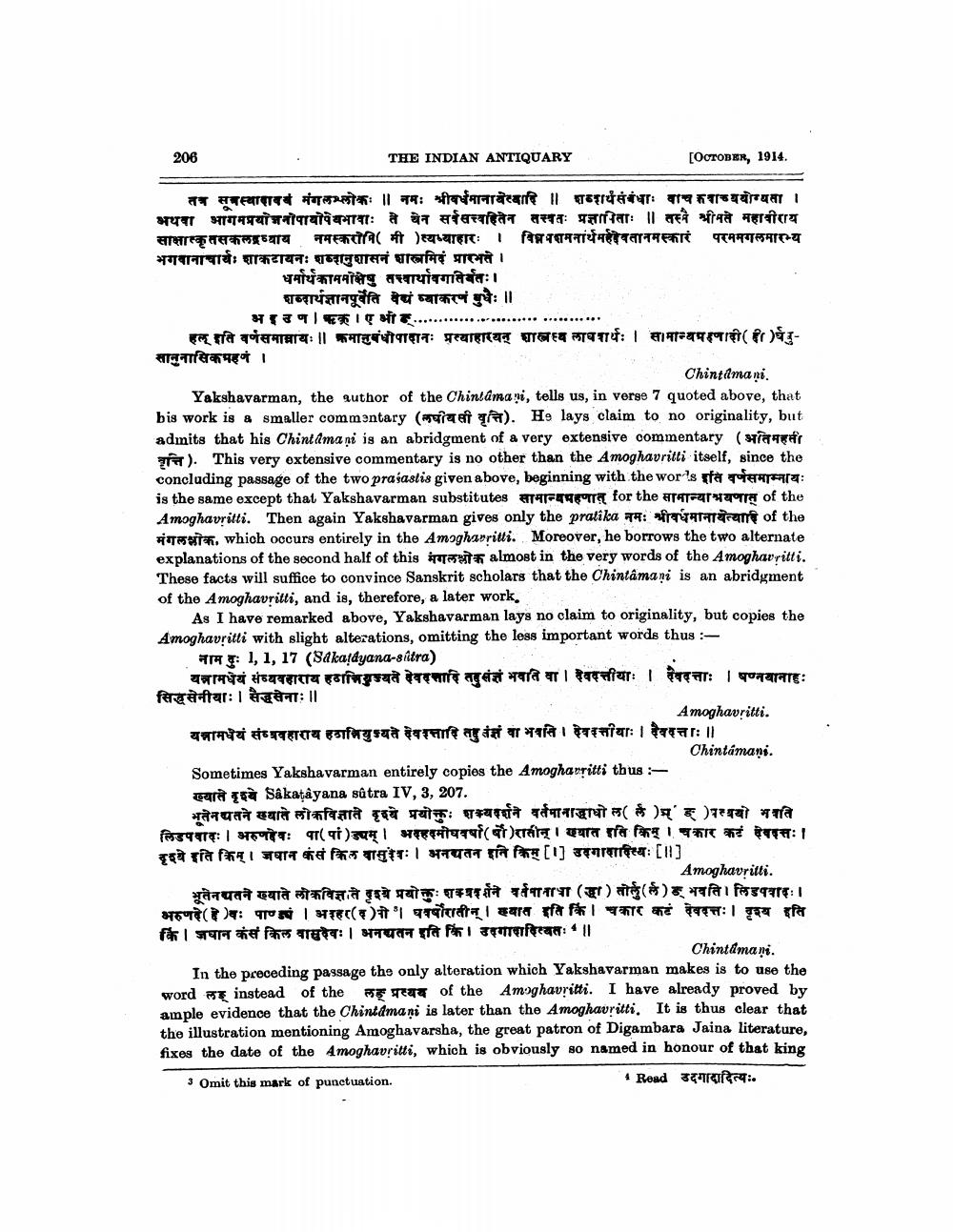________________
206
THE INDIAN ANTIQUARY
[OCTOBEIR, 1914.
तत्र सबस्थावावर्व मंगलश्लोकः ॥ नमः श्रीवर्धमानावेत्यादि । शायंसंबंधाः वाचकवाच्ययोग्यता । अथवा भागमप्रयोजनोपावोपेवभावाः ते बेन सर्वसत्त्वहितेन तस्वतः प्रज्ञापिताः ॥ तस्मै श्रीमते महावीराय साक्षात्कृतसकलद्रव्याय नमस्करोमि( मी त्यभ्याहारः । विनपशमनार्थमहदेवतानमस्कारं परममगलमारभ्य भगवानाचार्यः शाकटायनः शब्दानुशासनं शास्त्रमिदं प्रारभते।
धर्मार्थकाममोक्षेषु तत्वार्थावगतिर्वतः।
शब्दार्थज्ञानपूर्वेति वेचं व्बाकर बुधैः॥
भाउण|फकाए भी ................................ हल् इति वर्णसमानायः॥ क्रमानुबंधोपादानः प्रत्याहारयन् शास्त्रस्य लापार्थः । सामान्यपणादी(द)सानुनासिकमहणं ।
Chintamani. Yakshavarman, the author of the Chintamani, tells us, in verse 7 quoted above, that bis work is a smaller commentary (लघीयसी वृत्ति). He lays claim to no originality, but admits that his Chintamani is an abridgment of a very extensive commentary (अतिमहती वृत्ति). This very extensive commentary is no other than the Amoghavritti itself, since the concluding passage of the twoprayastis given above, beginning with the words इति वर्षसमाम्नायः is the same except that Yakshavarman substitutes सामान्बमहणात for the सामान्याश्रयणात् of the Amoghavritti. Then again Yakshavarman gives only the pratika नमः श्रीवर्धमानावेत्यादि of the मंगलनोक. which occurs entirely in the Amogharritti.. Moreover, he borrows the two alternate explanations of the second half of this
i s almost in the very words of the Amoghavritti. These facts will suffice to convince Sanskrit scholars that the Chintamani is an abridgment of the Amoghavritti, and is, therefore, a later work.
As I have remarked above, Yakshavarman lays no claim to originality, but copies the Amoghavritti with slight alterations, omitting the less important words thus - . नाम दुः 1,1, 17 (Sakatayana-sitra)
यन्नामधेयं संव्यवहाराय हानियज्यते देवतादि तहसंशं भवति वा । देवदत्तीयाः । देवदत्ताः । षण्मयानाहः सिद्धसेनीयाः। सैजुसेनाः॥
Amoghavritti. यन्नामधेयं संव्यवहाराय हठानियुज्यते देवरत्तादित संझं वा भवति । देवदत्तीयाः । देवदत्ताः॥
Chintamani. Sometimes Yakshavarman entirely copies the Amoghavritti thus - ख्याते दृश्ये Sakatayana sutra IV, 3, 207.
भतेनयतने ख्याते लोकविज्ञाते दृश्ये प्रयोक्तः शश्यदर्शने वर्तमानाद्धाधो ल(लै )प्रह)प्रत्ययो भवति लिडपवादः | अरुणदेवः पा(पां)ड्यम् । अवहदमोघवर्षा(ों)रातीन् । ण्यात इति किम् । चकार कटं देवदतः। दृश्ये इति किम् । जघान कंस किल वासुदेवः । अनयतन इनि किम् [1] उदगागादिस्यः [1]
Amoghavritti. भूतेनयतने ख्याते लोकविज्ञाते दृश्ये प्रयोक्तः शयदर्शने वर्तमानाश (खा) तो (ले) भवति। लिडपवादः । भरुणदेवः पापं | अइहर(द)ो घवषारातीन् । यात इति कि। चकार कटं देवदत्तः। तृश्य इति किं । जघान कंसं किल वासुदेवः। अनद्यतन इति किं । उदगारादित्वतः ॥
Chintamani. In the preceding passage the only alteration which Yakshavarman makes is to use the word instead of the E a of the Amoghavritti. I have already proved by ample evidence that the Chintamani is later than the Amoghavritti. It is thus clear that the illustration mentioning Amoghavarsha, the great patron of Digambara Jaina literature, fixes the date of the Amoghavritti, which is obviously so named in honour of that king
3 Omit this mark of punctuation.
+ Road उदगादादित्यः.




